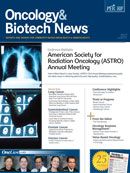Publication
Article
Oncology & Biotech News
SCLC on the Wane, but Difficult to Treat
Author(s):
Patients with limited and extensive SCLC show incremental gains with different treatment strategies but so far novel agents have failed to make a difference in outcomes.
Corey J. Langer, MD
Small cell lung cancer (SCLC) is challenging to treat. While studies of patients with limited and extensive disease show incremental gains with different treatment strategies, thus far, novel agents have failed to make a difference in outcomes. At the recent Chemotherapy Foundation Symposium, Corey J. Langer, MD, director of the Abramson Cancer Center of the University of Pennsylvania in Philadelphia, brought attendees up to date on the therapeutic state of the art for SCLC.
In 2011, SCLC accounted for about 13% of all cases of lung cancer, and NSCLC for about 87%. SCLC is related to cigarette smoking, so perhaps the decline in rates of occurrence has to do with fewer people smoking. The disease progresses quickly, and stage is critical to outcome. About one-third of patients with SCLC present with limited disease, and they have a 5-year survival rate of about 15% to 25%.
Early concurrent chemoradiation has been found superior to late concurrent therapy or sequential treatment in limited-stage disease. An ongoing Cancer and Leukemia Group B (CALGB) trial is comparing this approach of early concurrent chemoradiation versus 2 different versions of concurrent chemoradiation in patients with limited-stage disease: once daily radiotherapy to a total dose of 70 Gy and once-daily radiation with concomitant boost during the last 8 days of treatment to a total dose of 61.2 Gy. Accrual to this trial has been very slow; more than 3 years later, fewer than one-third the number of targeted patients has enrolled. The protocol has been amended to allow radiation to begin during cycle 2 instead of cycle 1 in hopes of increasing the rate of enrollment.
The ongoing Concurrent Once-Daily Versus Twice-Daily RadioTherapy (CONVERT; EORTC 08072) trial in Europe is studying a similar approach. The outcomes of both these trials should show which is the better strategy.
The brain is a common site of metastasis in limited-stage SCLC, with 50% to 80% of patients who do not undergo prophylactic cranial irradiation developing brain metastasis. Studies have shown an absolute survival benefit of 5.4% at 3 years with prophylactic cranial irradiation (PCI) in patients who do not progress on initial therapy (from 15.3% to 20.7%; P =.01). PCI is now standard practice following chemoradiation in patients with limited-stage SCLC. However, using newer agents or vaccines as maintenance therapy has not improved survival in limited-stage SCLC.
Chemotherapy alone is the standard approach for the two-thirds of patients who present with extensive SCLC. Palliative radiotherapy can be used to treat brain metastases, bone lesions, and obstructive pulmonary lesions. However, full-dose radiotherapy has no role in treating the primary tumor of the mediastinum.
In North America, the standard regimen is the combination of etoposide plus platinum (EP, either carboplatin or cisplatin) for 4 to 6 cycles. Carboplatin has less toxicity, but both drugs achieved similar results in long-term survival. In Japan, the combination of irinotecan plus cisplatin (IP) had a survival benefit over standard EP; median survival was 12.8 months compared with 9.4 months, respectively, and 2-year survival rates were 19.5% versus 5.2%, respectively.
However, trials in North America and Europe failed to replicate these results, and myelosuppression was worse with EP, Langer explained. For relapsed disease, topotecan can improve outcomes. Intravenous topotecan is the only FDA-approved drug for relapsed SCLC, “which is a frustration,” Langer said. Oral topotecan is therapeutically equivalent to intravenous topotecan and has shown superiority against best supportive care, as well as a statistically significant improvement in median survival (26 wk vs 14 wk) in patients with relapsed SCLC.
More recently, amrubicin has shown promising results in chemosensitive and chemorefractory SCLC. A phase III trial showed that amrubicin achieved superior progression-free survival compared with topotecan but failed to show an overall survival advantage. A subgroup analysis found that there was a survival advantage in chemoresistant patients only.
Other trials of novel agents in SCLC have all been negative, according to Langer. “Is SCLC challenging to treat? You betcha,” he concluded.
































%20(2)%201-Recovered-Recovered-Recovered-Recovered-Recovered-Recovered-Recovered-Recovered-Recovered-Recovered-Recovered-Recovered-Recovered-Recovered-Recovered-Recovered-Recovered.jpg?fit=crop&auto=format)
%20(2)%201-Recovered-Recovered-Recovered-Recovered-Recovered-Recovered-Recovered-Recovered-Recovered-Recovered-Recovered-Recovered-Recovered-Recovered-Recovered-Recovered-Recovered.jpg?fit=crop&auto=format)
